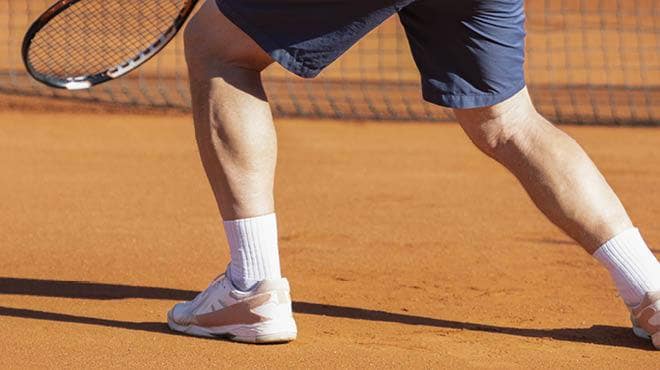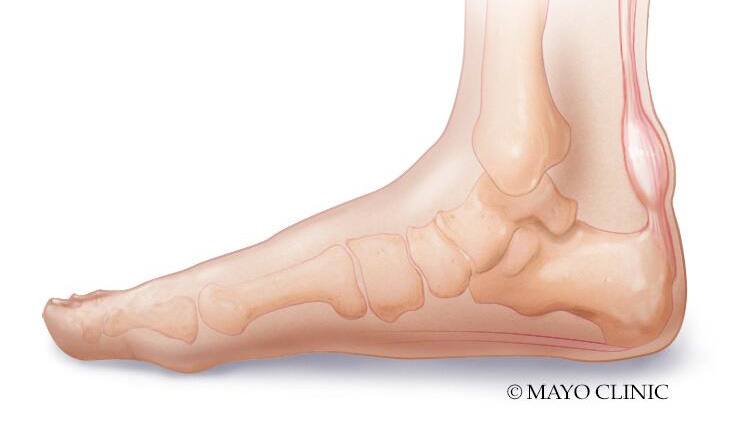Diagnosis
During the physical exam, your healthcare professional will press gently on the area to find where the pain, tenderness or swelling are and watch how the foot and ankle look moving and at rest.
Imaging tests
One or more of these tests can help diagnose Achilles tendinitis:
- X-rays. X-rays do not show soft tissues such as tendons. But they may show some signs of Achilles tendinitis and can help rule out other conditions that can cause some of the same symptoms.
- Ultrasound. This device uses sound waves to look at soft tissues such as tendons. Ultrasound also can make real-time images of the Achilles tendon to show how it moves. And color-Doppler ultrasound can look at blood flow around the tendon.
- MRI. Using radio waves and a strong magnet, MRI scans can show the Achilles tendon in detail.
Treatment
Tendinitis most often does well with self-care. But if your symptoms are severe or long-lasting, other treatments to try might include the following.
Medicines
Pain medicines you can get without a prescription might help. These include ibuprofen (Advil, Motrin IB, others) or naproxen sodium (Aleve). If these don't help enough, you might get a prescription for medicines to reduce swelling and irritation, called inflammation, and relieve pain.
One prescription option is a nitroglycerin patch. You put the patch on the tendon to help with healing and pain relief. You might need to put the patch on the sore part of the tendon every day for 2 to 3 months.
Physical therapy
A physical therapist might suggest the following:
- Exercise. A therapist might prescribe exercises designed to heal and strengthen the Achilles tendon. Resistance exercises using heavy loads, such as weighted heel raises, might be especially helpful for ongoing, called chronic, Achilles tendinitis.
- Orthotic devices. A shoe insert or wedge that slightly raises your heel can relieve strain on the tendon. For some tendon pain, a heel pad can cushion the sore area.
Newer therapies
These therapies have been used for Achilles tendinitis with some success:
-
Extracorporeal shock wave therapy (ESWT). This treatment doesn't require cutting into the body, called noninvasive. It sends shock waves to injured tissue to relieve pain and help with healing. It often is used when self-care measures haven't worked but before deciding on surgery.
Treatment involves having a series of sessions that each last 30 minutes or less. Side effects usually are mild. They might include bruising, swelling, pain, numbness or tingling in the treated area.
- Platelet-rich plasma. This treatment, given as shots, uses a person's own platelets. Platelets are cells in the that form clots to stop bleeding and start healing. PRP has growth factors that may help the body heal.
-
Ultrasound-guided tenotomy. This treatment uses a special device to break up damaged parts of the tendon and remove unhealthy tissue. The procedure is done through a small cut. Ultrasound guides the device.
The procedure gets the tendon to start healing. For the first few weeks, you'll need crutches and a walking boot. It usually takes several months for the tendon to fully heal.
-
Ultrasound-guided tendon scraping. In tendinopathy, tiny nerves and vessels grow into the tendon that may cause pain. Tendon scraping is a procedure done through a small cut. Ultrasound guides the device.
The device scrapes the surface of the tendon. It disconnects the unusual nerves and vessels. This can give quick pain relief and a return to activities within a week.
Surgery
If several months of more-conservative treatments don't work or if the tendon has torn, you might need traditional surgery to repair your Achilles tendon.
From Mayo Clinic to your inbox
Self care
Self-care includes the following, often known as R.I.C.E.:
- Rest. You may need to not exercise for several days. Or you can do activities that don't strain the Achilles tendon, such as swimming or deep-water running. For severe Achilles tendinitis, you might need to wear a walking boot and use crutches.
- Ice. To lessen pain or swelling, apply an ice pack to the tendon for about 15 minutes after exercising or when you feel pain.
- Compression. Wraps or elastic bandages that hold in the affected area can help reduce swelling and keep the tendon from moving much.
- Elevation. Raise the affected foot above the level of your heart to reduce swelling. Sleep with your affected foot raised at night.
Preparing for your appointment
You'll likely first contact your family healthcare professional. You might be sent to a doctor specializing in sports medicine or physical and rehabilitative medicine, called a physiatrist. If your Achilles tendon has torn, you may need to see an orthopedic surgeon.
What you can do
Before your appointment, you may want to write a list of answers to the following questions:
- Did the pain begin suddenly or come on little by little?
- Are symptoms worse at certain times of day or after certain activities?
- What shoes do you wear during exercise?
- What medicines and supplements do you take regularly?
What to expect from your doctor
A member of your healthcare team might ask you:
- Where exactly does it hurt?
- Does the pain get better with rest?
- What is your usual exercise routine?
- Have you recently made changes to your exercise routine, or have you recently started a new sport?
- What have you done for pain relief?

